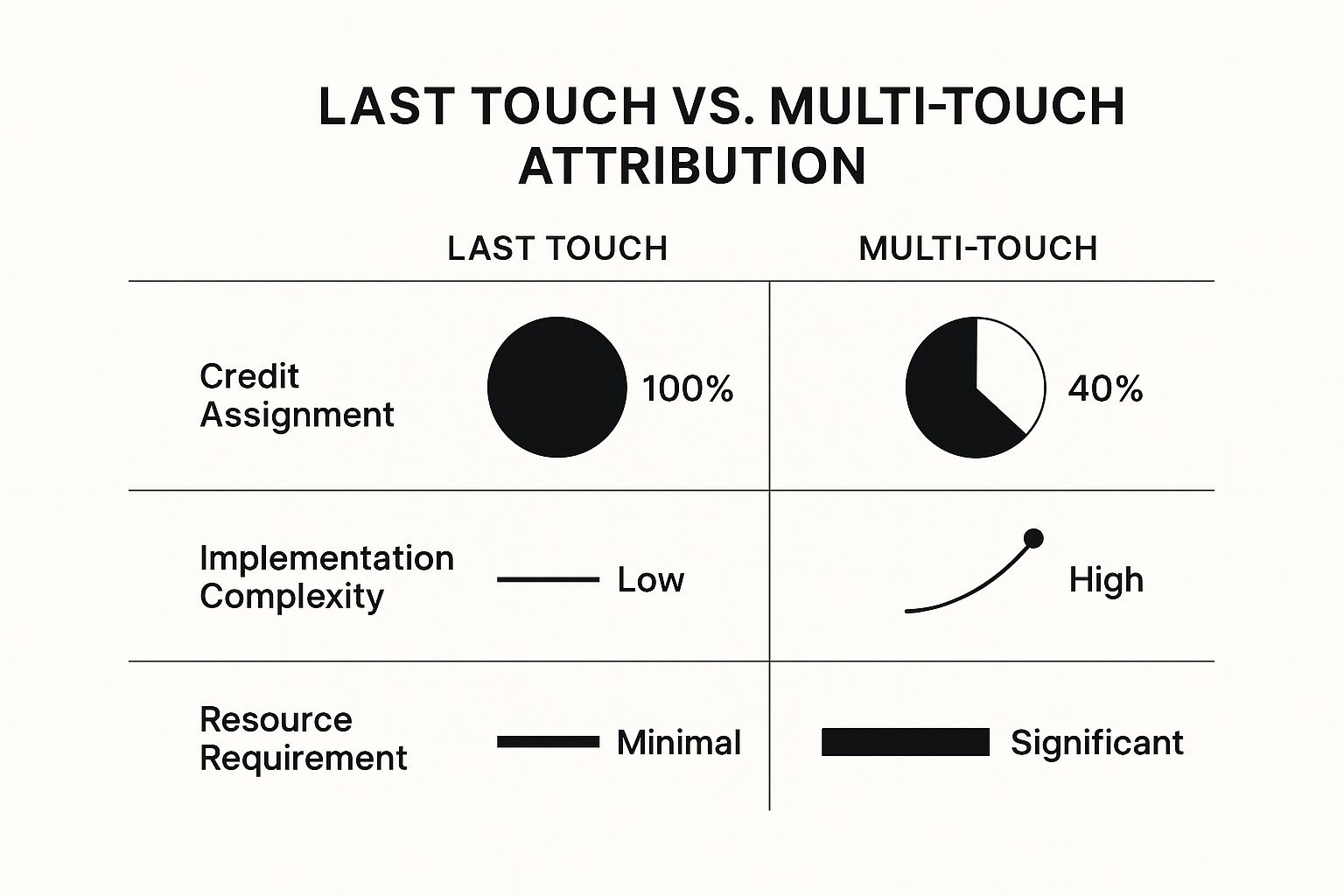The Truth About Last Touch Attribution
Last touch attribution, in its simplest form, assigns 100% of the credit for a conversion to the last touchpoint a customer interacts with before purchasing. Imagine a customer first sees your advertisement on Instagram, then clicks a link in your email newsletter a week later, and finally buys something directly from your website. Last touch attribution would disregard the Instagram ad and the email, attributing the entire sale to the direct website visit. While this offers a seemingly straightforward view of what finalized the sale, this simplicity can be misleading.
This simplified view persists because it's the default setting in many analytics platforms, like Google Analytics, which uses 'last non-direct click'. Consequently, many UK marketers depend on this model without fully understanding its implications. A recent study revealed that 41% of marketers globally identified last-touch as their most-used attribution method, primarily because it's the default in many common tools. This trend likely reflects UK adoption patterns as well. Learn more about marketing attribution statistics: Marketing Attribution Stats.
Understanding the Drawbacks of a Simplified Approach
Last touch attribution, while providing a simple method for measuring conversions, fails to represent the multifaceted nature of modern customer journeys. It can significantly undervalue top-of-funnel marketing like social media or content marketing, which are crucial for brand awareness and initial engagement. In the UK, where consumers frequently engage with brands across multiple channels before purchasing, this can distort data and lead to poorly informed budget allocation.
How Last Touch Impacts Marketing Strategies
Consider a London-based small business investing heavily in a Facebook ad campaign for a new product launch. The campaign generates substantial interest and directs traffic to the business's website. However, many customers may not purchase immediately. They might return later via a Google search or direct link to complete the purchase. With last touch attribution, the Facebook campaign receives minimal credit, despite its key role in introducing the product. This can lead businesses to mistakenly deprioritize effective top-of-funnel strategies.
The Need for a More Nuanced View
The shortcomings of last touch attribution underscore the need for a more comprehensive approach to understanding the customer journey. While simple to implement, it offers an incomplete and potentially inaccurate picture of what truly drives conversions. This oversimplified perspective hinders businesses from optimizing their marketing for maximum impact. The following sections will discuss alternative attribution models that offer a more precise and complete view of how different marketing channels collaborate to generate sales.
Why Last Touch Attribution Fails Modern Marketers

Last touch attribution often provides an incomplete view of the customer journey. In today's diverse marketing landscape, consumers frequently interact with brands across numerous touchpoints before finally deciding to make a purchase. Focusing only on the last interaction disregards the valuable influence of earlier touchpoints.
For instance, a customer might first encounter your brand through an engaging social media campaign. Then, they might read your blog, subscribe to your email newsletter, and ultimately buy a product after clicking a retargeting ad. Last touch attribution would give all the credit to the retargeting ad. The important roles of social media and content marketing in nurturing that customer relationship would be completely overlooked. This creates a dangerous blind spot that can result in poorly informed budget decisions and the undervaluing of essential marketing activities.
The Problem with Oversimplification
Last touch attribution's appeal comes from its simplicity. It seems to offer a straightforward answer to the question of which channel drove the conversion. However, this simplicity comes at a cost. A 2021 study by Ruler Analytics found that 53.5% of marketers believed last-touch attribution was only 'somewhat effective', particularly for shorter sales cycles. It consistently undervalues earlier touchpoints, such as TV advertising or social media engagement, which often initiate the customer journey.
In situations where users interact with multiple channels (for example, a TV ad → social media → branded search → email) before converting, last-touch models solely credit the final touchpoint (the email campaign, in this example), as illustrated in a 2023 Sellforte example. While the study doesn't isolate specific UK data, the overall trend highlights the model's shortcomings in complex, multi-channel environments. This is particularly relevant for industries with longer decision-making processes. Learn more: Compared – Last Click Attribution and Media Mix Modeling. This oversimplified approach fails to account for the combined effect of various touchpoints, a crucial factor in industries with longer buying cycles. For more insights, consider reading: How to Master Sitemap Creation.
Undervaluing Upper-Funnel Activities
Crucial upper-funnel activities, essential for building brand awareness and driving initial engagement, are systematically undervalued by last touch attribution. Channels such as social media, content marketing, and public relations frequently introduce potential customers to your brand and cultivate their interest. Yet, these efforts rarely receive adequate credit in a last-touch model. This often leads to decreased investment in these vital areas.
The Impact on Budget Allocation
The inherent bias of last touch attribution can distort marketing budget allocation. By overemphasizing bottom-funnel activities, businesses risk underfunding the very channels responsible for generating initial interest and nurturing leads.
This can create a detrimental cycle. Investment in upper-funnel activities decreases, reducing their visibility in the attribution model and leading to even further disinvestment. Ultimately, this stifles long-term growth and limits overall marketing effectiveness.
To illustrate the significant impact of undervaluation, let's examine a few key marketing activities:
This distorted perspective can have severe consequences for businesses. Building strong brand awareness and fostering customer loyalty are paramount for sustained success. By failing to accurately represent the true value of all marketing channels, last touch attribution hinders informed decision-making and restricts growth potential. Moving beyond this limited model is vital for marketers seeking to maximize ROI and build sustainable businesses.
To better understand which marketing activities are commonly undervalued, consider the following table:
Marketing Activities Undervalued by Last Touch Attribution
This table reveals critical marketing channels that typically receive minimal credit in last touch attribution despite their substantial impact on driving conversions.
| Marketing Activity | Actual Role in Customer Journey | Recognition in Last Touch Model | Real Business Impact of Undervaluation |
|---|---|---|---|
| Social Media Marketing | Brand awareness, initial engagement, community building | Often only credited for direct conversions | Reduced brand visibility, missed opportunities for nurturing leads |
| Content Marketing | Educating prospects, building trust, driving organic traffic | Rarely credited unless directly leading to a sale | Decreased lead generation, weakened brand authority |
| Public Relations | Building brand reputation, generating positive media coverage | Difficult to measure and often ignored | Underestimation of brand-building efforts, missed opportunities for thought leadership |
| Email Marketing | Nurturing leads, driving repeat purchases | Primarily credited for final conversions, neglecting its role in lead nurturing | Reduced customer lifetime value, limited engagement |
The table above highlights how critical upper-funnel activities are often disregarded by last touch models. This can lead to misallocation of resources and a failure to recognize the full contribution of these channels. Shifting towards a more holistic attribution model is essential for accurately assessing marketing effectiveness and making informed decisions about budget allocation.
Beyond Last Click: Attribution Models That Actually Work

Moving past last-touch attribution isn't about adopting the most complicated model. It's about finding the right fit for your business. This involves balancing the need for valuable insights with practical application. This section explores various attribution models, from the straightforward first-touch model to more sophisticated data-driven methods. We’ll also examine how these models align with different business structures, campaign objectives, and varying customer journey complexities.
Exploring Alternative Attribution Models
Several attribution models offer a more complete picture than the last-touch method. First-touch attribution, for example, assigns 100% of the credit to the initial touchpoint a customer interacts with. This helps businesses understand which channels are most effective at driving initial brand awareness and attracting new customers. Imagine a customer first discovers your brand through an organic search. Weeks later, after several other interactions, they make a purchase after clicking a paid ad. First-touch attribution would assign all credit to that original organic search.
Other models distribute credit across multiple touchpoints. The linear model distributes credit equally among all touchpoints in the customer journey. While providing a comprehensive overview, it might not accurately reflect the relative influence of key touchpoints. The U-shaped model, by contrast, concentrates credit on the first and last touchpoints, recognizing their importance in initial engagement and final conversion. Similarly, the W-shaped model emphasizes the first, lead creation, and deal creation touchpoints, while still distributing some credit to other touchpoints. Finally, the time decay model prioritizes interactions closer to the conversion, recognizing the impact of recency.
Choosing the right model hinges on your business objectives. A first-touch model might be most suitable for businesses focused on brand building and top-of-funnel activities. For businesses with short, simple sales cycles, a last-touch model could suffice. For businesses with more complex customer journeys, models like time decay or W-shaped might provide a more accurate view.
Finding the Right Fit for Your Business
The complexity of the customer journey and the nature of your business significantly influence which attribution model best suits your needs. For businesses with longer sales cycles, such as those in finance or property, a time decay model could be highly beneficial as it reflects the importance of ongoing engagement. Businesses prioritizing lead generation may find a U-shaped or W-shaped model more effective, as they highlight the critical roles of lead creation and deal creation.
The data chart below visualizes the credit distribution across several attribution models based on a hypothetical customer journey.

This chart clarifies how each model distributes credit across touchpoints. For instance, in a five-touchpoint journey, the linear model assigns 20% credit to each, while the first-touch model attributes 100% to the initial touchpoint. This visualization allows marketers to quickly grasp the impact of each model.
To further assist in choosing the appropriate model, the table below offers a comprehensive comparison.
Attribution Models Compared: Finding Your Perfect Match
This comprehensive comparison reveals the strengths and weaknesses of major attribution models to help you select the approach that best aligns with your specific marketing objectives.
| Attribution Model | How It Actually Works | Key Advantages | Potential Drawbacks | Perfect Use Cases |
|---|---|---|---|---|
| First-Touch | Gives 100% of the credit to the first touchpoint. | Simple to understand; highlights top-of-funnel effectiveness. | Ignores later influential touchpoints. | Brand building campaigns; businesses focused on initial awareness. |
| Last-Touch | Gives 100% of the credit to the last touchpoint. | Easy to implement; often readily available in analytics platforms. | Overlooks earlier stages of the customer journey. | Businesses with short sales cycles; direct response campaigns. |
| Linear | Distributes credit evenly across all touchpoints. | Provides a balanced view of all contributing channels. | May not accurately reflect the impact of key touchpoints. | Businesses seeking a general overview of channel performance. |
| U-Shaped | Concentrates credit on the first and last touchpoints. | Recognizes the importance of both initial engagement and final conversion. | May underemphasize mid-funnel touchpoints. | Businesses focusing on both lead generation and closing deals. |
| W-Shaped | Emphasizes the first, lead creation, and deal creation touchpoints. | Highlights critical milestones in the sales process. | May not be suitable for all sales processes. | Businesses with complex sales cycles involving clear lead and deal stages. |
| Time Decay | Gives more weight to touchpoints closer to the conversion. | Acknowledges the influence of recent interactions. | May undervalue earlier touchpoints in longer sales cycles. | Businesses with longer sales cycles where nurturing plays a key role. |
This table provides a clear overview of various attribution models, aiding in selecting the most effective one for your specific needs.
Implementation Considerations
Implementing a new attribution model requires careful planning. Platforms like HubSpot offer built-in attribution models, simplifying the process. Others may require integrations or custom development. Moving from a last-click mindset also necessitates team training and a willingness to re-evaluate existing marketing strategies. However, this shift empowers you with a more comprehensive understanding of how each marketing channel contributes to the overall customer journey and how to optimize resource allocation effectively.
How Last Touch Attribution Silently Drains Your Budget

Inaccurate attribution can significantly impact your marketing budget. While seemingly straightforward, last touch attribution can misrepresent the complexities of the customer journey, leading to inefficient spending. This section explores how this model can subtly, yet substantially, drain your marketing resources.
A primary issue with last touch attribution is the over-crediting of bottom-funnel activities like email marketing and retargeting ads. While these tactics are crucial for converting sales-ready customers, they often aren't the primary drivers of initial interest.
For example, a customer might discover your brand through a social media campaign, research your products via organic search, and finally purchase after seeing a retargeting ad. Last touch attribution would assign 100% of the credit to the retargeting ad, overlooking the earlier touchpoints. This often leads to overspending on retargeting while underfunding other vital channels.
This misallocation creates a vicious cycle. By overemphasizing the final touchpoint, marketers invest disproportionately in bottom-funnel activities. This starves the channels responsible for building brand awareness and nurturing initial interest, shrinking the potential customer pipeline.
Consequently, this reinforces the perceived importance of bottom-funnel tactics, further exacerbating the problem.
This misattribution also undervalues upper-funnel activities like brand-building campaigns, content marketing, and public relations. These efforts play a crucial role in shaping brand perception and driving initial engagement, ultimately fueling the entire sales funnel. Matomo's 2023 analysis highlights this problem, emphasizing how last touch attribution overlooks crucial mid-funnel touchpoints. This creates reporting bias, favoring bottom-funnel channels at the expense of essential top-of-funnel efforts. Learn more: Multi-Touch Attribution. You might also find this helpful: Navigating the Sitemap Landscape.
Recognizing the Warning Signs
Several warning signs indicate your last touch attribution model might be misleading you. These include:
- A disproportionately high percentage of conversion credit attributed to bottom-funnel activities.
- Declining ROI on upper-funnel initiatives despite qualitative evidence of their effectiveness.
- Stagnation in new customer acquisition.
By recognizing these warning signs and understanding the limitations of last touch attribution, businesses can avoid costly budget misallocation. Shifting to a more holistic attribution model that recognizes the contribution of all touchpoints is crucial for sustainable growth. This allows you to identify which activities truly drive engagement and long-term value, leading to more informed budget decisions and a more strategic marketing approach.
Building Your Better Attribution Framework
Moving away from last-touch attribution doesn't require a complete overhaul of your analytics system. It's about making smart, incremental changes. This section offers a practical guide to improve your measurement approach with minimal disruption, concentrating on manageable steps for better marketing insights.
Step-by-Step Improvements for Better Attribution
Begin with simple, high-impact adjustments. A good first step is incorporating first-touch data alongside your current last-touch data. This provides a more complete view of the customer journey by highlighting the channels that initially attract customers.
For instance, you might find that your social media campaigns consistently introduce new customers, but rarely receive credit in a last-touch model. This simple addition can uncover hidden value in your top-of-funnel marketing efforts.
Next, experiment with a linear attribution model. This model distributes credit equally across all touchpoints. While not a perfect solution, it offers a more balanced perspective than focusing solely on the last touch.
This allows you to see the contributions of mid-funnel activities that might otherwise be overlooked, helping you understand how different channels work together instead of viewing them in isolation.
Leveraging Platform Capabilities and Integrations
Many analytics platforms offer built-in support for different attribution models. Explore the features available within your existing tools. Platforms like HubSpot offer a variety of attribution models, allowing you to switch between them easily.
This removes the need for complex custom implementations, making valuable insights readily accessible. You might also be interested in learning how sitemaps can improve your website's visibility: How to Master Sitemap Creation.
For more advanced requirements, consider integrations with dedicated attribution platforms. These tools often offer more sophisticated models and more detailed customer behavior insights. However, carefully weigh the costs and complexity before committing to a new platform.
Addressing Implementation Challenges
Implementing new attribution models can present some challenges. Data integration can be complex, especially when working with multiple platforms. Ensuring accurate data flow between your systems is crucial for reliable reporting.
Shifting your team’s mindset away from last-click attribution also requires careful change management. Educate your team on the advantages of a more holistic approach. This ensures everyone understands the reasons for the change and supports the new strategy.
Moving Beyond Last-Click Thinking
Changing ingrained habits requires ongoing effort. Encourage your team to consider the whole customer journey, not just the final conversion. This might involve incorporating a wider range of metrics into performance reviews.
For example, consider metrics like brand awareness, engagement, and lead generation, in addition to sales conversions. This encourages a more balanced perspective and a more strategic approach to marketing.
By gradually implementing these changes and focusing on achievable improvements, you can transition to a better attribution framework. This will provide more accurate and valuable marketing insights, enabling data-driven decisions that optimize your marketing spend and drive business growth.
When Last Touch Attribution Actually Makes Sense

While we've discussed the shortcomings of last touch attribution, it's not always the wrong approach. Sometimes, its simplicity can be useful. Understanding when to use last touch attribution is key for accurate marketing measurement. This section explores scenarios where it can be a valuable tool.
Simple Sales Cycles and Direct Response
Last touch attribution works well with short, simple sales cycles. For example, imagine a promotion on Instagram encouraging direct purchases through a link. Attributing the sale to that final click makes sense. The customer journey is usually linear, with few touchpoints. The last interaction often directly leads to conversion.
Last touch attribution can also analyze direct response campaigns like paid search ads or limited-time email discounts. These campaigns are designed to trigger immediate actions, making the final click significant.
Brand Awareness and Top-of-Funnel Ignored
However, even in these scenarios, relying only on last touch attribution can be problematic. It ignores brand-building and top-of-funnel activities crucial for long-term growth. This can create a misleading view, causing overinvestment in short-term gains while neglecting sustainable customer relationships.
Combining Last Touch With Other Models
One solution is combining last touch with other attribution models. Using first touch data alongside last touch data offers a wider perspective. Last touch shows the closing action, while first touch reveals the initial point of contact. This combined approach provides a more holistic view of the customer journey.
Resource Constraints and Practical Applications
For smaller businesses or teams with limited resources, last touch attribution offers a simple starting point. It's easy to set up and track, especially with limited data or budget for complex attribution software. It's not perfect, but it's a practical approach for measuring results when resources are tight.
Building a Balanced Measurement Ecosystem
Effective use of last touch attribution requires a balanced approach. Supplement last touch data with other sources, such as customer surveys, qualitative feedback, and behavioral analysis. This broader perspective compensates for the limitations of last touch attribution, enabling more informed decisions.
By understanding the appropriate use cases for last touch attribution and integrating it with other methods, you can create a more balanced and effective measurement system. This empowers data-driven decisions to optimize your marketing spend and drive business growth.
Ready to improve your TikTok Shop profits and gain a deeper understanding of your sales data? Explore Mergoio today!

Leave a Reply